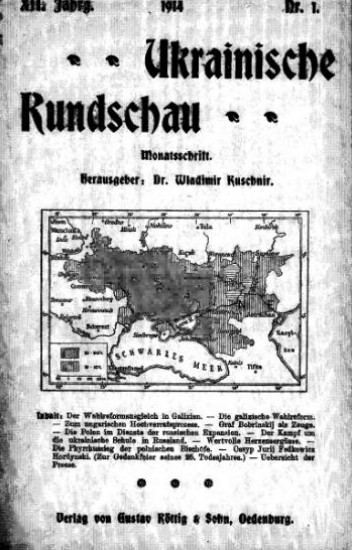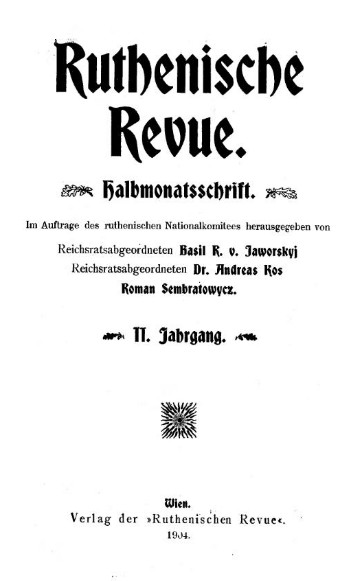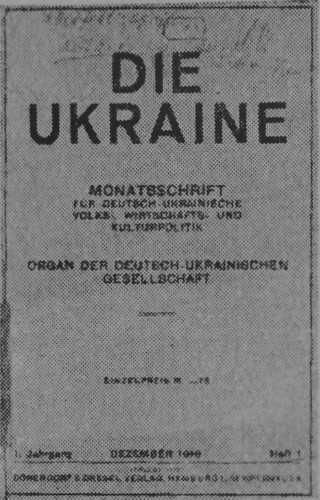Press and information bureaus abroad
Press and information bureaus abroad. In the second half of the 19th century, Ukrainian émigrés (Mykhailo Drahomanov and his Geneva circle), Galician and Bukovynian parliamentarians in Vienna, and Ivan Franko and other Galician publicists began informing the Western press and public about Ukrainian affairs, the national oppression of the Ukrainians, and the goals of the Ukrainian national movement. In the Russian Empire, members of the Saint Petersburg Ukrainian Hromada and later the State Duma, particularly Mykola Kostomarov, Panteleimon Kulish, Danylo Mordovets, Oleksander Lototsky, Petro Stebnytsky, Mykhailo Mohyliansky, Oleksander Salikovsky, Mykhailo Hrushevsky, Maksym Slavinsky, Symon Petliura, Pavlo Chyzhevsky, Volodymyr Shemet, and Illia Shrah, played a similar role by contributing articles to influential Russian publications and later issuing their own periodicals, such as Ukrainskii vestnik (Saint Petersburg) (1906) and Ukrainskaia zhizn’ (Moscow) (1912–17).
From 1900 to 1920 the principal foreign center of information about Ukraine was Vienna. There Roman Sembratovych edited the Ukrainian affairs journals X-Strahlen (1901–2) and Ruthenische Revue (1903–5), and Volodymyr Kushnir edited Ukrainische Rundschau (1906–14). In 1907 Kushnir established the first independent Ukrainian press bureau in Vienna. Elsewhere in Europe similar efforts were made by Yaroslav Fedorchuk in Geneva and Paris, Volodymyr Stepankivsky and George Raffalovich in London, Olgerd Ippolit Bochkovsky in Prague, and L. Drahomanova and her husband, Ivan Shishmanov, in Sofia. In 1912 a short-lived Ukrainian Information Committee was initiated by Andrii Zhuk in Lviv.
During the First World War the General Ukrainian Council in Vienna published in German the information weeklies Ukrainisches Korrespondenzblatt (1914–16) and Ukrainische Korrespondenz (1917–18). The Vienna-based Union for the Liberation of Ukraine (SVU) published Ukrainische Nachrichten (1914–18) and Ukrainische Blätter (1916–18) in Vienna, La Revue ukranienne (1915–17) in Lausanne, Switzerland, and pro-Ukrainian propaganda in 11 European languages. Also in Lausanne, Volodymyr Stepankivsky organized a Ukrainian Bureau and published L’Ukraine (1915–20) and, irregularly, The Ukraine. The bureau disseminated the latest news about Ukraine, which it received from Ivan Nimchuk and Ivan Krevetsky, who worked for the Press Bureau of the Austrian Ministry of War. In Berlin a Ukrainian Press Bureau was organized by Dmytro Dontsov and funded by the Ukrainian Parliamentary Representation; it published Nachrichten des Ukrainischen Pressbüros and political brochures in 1914–16. In 1916 Dontsov moved to Bern, Switzerland, where until March 1917 he headed the Bureau of Nationalities of Russia and published in German, French, and English the bulletin Korrespondenz der Nationalitüaten Russlands, funded by Volodymyr Stepankivsky. In Budapest Hiiador Strypsky published, in co-operation with the SVU, the Hungarian-language monthly Ukránia (1916–17). In the United States two organizations—the Ukrainian National Council, later Ukrainian National Committee (United States) and the Federation of Ukrainians in the United States—published a number of information bulletins and brochures.
After the creation of the Ukrainian Central Rada in 1917, and particularly after the proclamation of Ukrainian independence in January 1918, information services became the responsibility of government agencies, notably of Ukrainian consulates and missions abroad, which were allotted funds for this purpose from the state budget. In addition a private Ukrainian press bureau functioned in Vienna under the direction of V. Biberovych and M. Bardakh briefly in 1917. The 1918 Hetman government’s Ministry of Internal Affairs established a Ukrainian Telegraph Agency (UTA) and State Press Bureau; headed by Dmytro Dontsov, the UTA systematically published press bulletins in various European languages. In Vienna in 1918, Volodymyr Kalynovych published Ukrainische Blätter, and late that year the Directory of the Ukrainian National Republic established a Ukrainian Press Service (UPS) there. Headed by V. Bryndzan and O. Kushchak, the UPS was financed initially by the Western Ukrainian National Republic (ZUNR) mission in Vienna and in 1919–20 by the Ukrainian National Republic (UNR) mission. It was the main Ukrainian information agency in Europe at the time. In addition press bureaus attached to UNR missions in London, Sofia, The Hague, Copenhagen, Berlin, Budapest, Helsinki, Paris, Bern, Lausanne, Athens, and New York issued bulletins in the official languages of their host countries. Particularly comprehensive press and information activities were conducted by the UNR and ZUNR delegations at the Paris Peace Conference, to countervail the Polish and Russian émigré lobbies there.
In the interwar period the Government-in-exile of the Western Ukrainian National Republic established a press bureau in Vienna; headed by V. Biberovych, it functioned from early 1920 to March 1923. Until 1939 the Government-in-exile of the Ukrainian National Republic conducted an intensive information campaign through its various representatives employed by foreign press agencies (eg, Mykola M. Kovalevsky, Mykhailo Yeremiiv) and through its missions, primarily that in Paris, which subsidized the periodicals L’Europe orientale (1919–20), France et L’Ukraine (1920), Prométhée (1924–38), L’Ukraine nouvelle (1927–9), Bulletin du Bureau de Presse ukrainienne (1934–9), La Revue de Prométhée (1938–40), and other publications. In Switzerland M. Yeremiiv’s Ofinor agency issued press bulletins in German, French, and Ukrainian in Geneva (1928–44); in French (1929–39) and Spanish (1932–6) in Paris; and in Italian in Rome (1929–43). In Berlin a government-supported German-Ukrainian Society published the journal Die Ukraine (1918–26). Other news and information periodicals were also published there: Deutsch-Ukrainische Zeitung (1920), edited by H. Kliuk; Osteuropäische Korrespondenz (1926–34), edited by Zenon Kuzelia and Riko Jary; and Ukrainische Kulturberichte (1933–40), published by the Ukrainian Scientific Institute in Berlin. The Ukrainian Bureau in London, headed by Vladimir Kaye-Kysilewsky, published several bulletins from 1930 to 1939, and a group of Hetmanite supporters published the bulletin The Investigator (1932–4), edited by Volodymyr Korostovets. In Prague Ukraïns’ka korespondentsiia (1930–1) and Ukrajina published information in Czech, and Maksym Hekhter wrote on Ukrainian affairs in the journals Prager Presse (1921–38) and Slavische Rundschau (1929–40). In Warsaw the Ukrainian question in Poland was illuminated in Natio (1926–7), a monthly edited by Pavlo Lysiak and published in English, French, German, and Polish, and in the weekly Biuletyn Polsko-Ukraiński (1932–8) and monthly Problemy Europy Wschodniej (1939), edited by W. Bączkowski.
In the 1930s the Organization of Ukrainian Nationalists (OUN) developed its own press and information network in Europe. Its Ukrainian Press Service in Berlin published the bulletin Ukrainischer Pressedienst, edited by Mykhailo Seleshko (1931–4) and Volodymyr Stakhiv (1937–41). In New York the OUN ran a Ukrainian Press Service from 1938 to 1941 under the direction of Ye. Skotsko. It also issued Bulletin d’informations ukrainiennes (ed Makar Kushnir) in Geneva, a bulletin in English (ed Yevhen Liakhovych [1933–5] and S. Davidovich [1938–9]) in London, and bulletins in other languages in Rome, Prague, Kaunas, Paris, Vienna, and Madrid.
After the Second World War, information about Ukraine was disseminated in the West by various Ukrainian political and community organizations in Western Europe and the New World. Information in several languages was released by the Munich-based Ukrainian Supreme Liberation Council (UHVR) and Ukrainian National Council. English-language news and analyses of developments in Ukraine was published in Jersey City, New Jersey, in the Ukrainian National Association’s Ukrainian Weekly (est 1933); in New York in the Ukrainian Congress Committee of America’s Ukrainian Quarterly (est 1944) and biweekly Ukrainian Bulletin (1951–70), in the Prolog Research Corporation’s Digest of the Soviet Ukrainian Press (1957–77) and Prolog (1957–61), and, in the early 1980s, in the Herald of Repression in Ukraine (ed Nadiia Svitlychna) of the External Representation of the Ukrainian Helsinki Group; in Munich in the Anti-Bolshevik Bloc of Nations’ ABN Correspondence (est 1950) and the quarterly Problems of the Peoples of the USSR of the League for the Liberation of the Peoples of the USSR; in London in the Association of Ukrainians in Great Britain’s Ukrainian Review (est 1954) and, in the mid-1980s, in the Prolog-funded Focus on Ukraine and Soviet Nationality Survey; in Baltimore, Maryland, in the Smoloskyp information service’s Smoloskyp (est 1974); and in Toronto in the World Congress of Free Ukrainians’ Ukrainian Newsletter (est 1980). In the late 1980s the London-based Ukrainian Press Agency, directed by Taras Kuzio, issued press releases about developments in Ukraine. Information has appeared in German in Ukraine in Vergangenheit und Gegenwart (1952–7, 1962–8) in Munich; in Portuguese in Boletim informativo (1946–9), a monthly published in Curitiba, Brazil, by a UHVR-affiliated Ukrainian Press Service; in Spanish in Ucrania Libre, published in the 1950s by a Ukrainian Information Bureau in Buenos Aires, Argentina, and in a Spanish version of Smoloskyp (est 1975); in Italian in Ucraina (1954–6, ed Vasyl Fedoronchuk) and in press releases issued by a Ukrainian Press Bureau (est 1985) monitoring religious affairs in Ukraine, in Rome; and in French in L’Est européen (est 1960), Echoes d’Ukraine (1962–9), Bulletin Franco–Ukrainien (1959–70), and Echanges: Revue franco-ukrainienne (est 1971) in Paris.
Notable non-Ukrainian institutions that issued information on and analyses of developments in Ukraine are Radio Liberty and the Institute for the Study of the USSR in Munich, Vatican Radio, and Keston College in England.
Vasyl Markus
[This article originally appeared in the Encyclopedia of Ukraine, vol. 4 (1993).]



.jpg)
.jpg)
